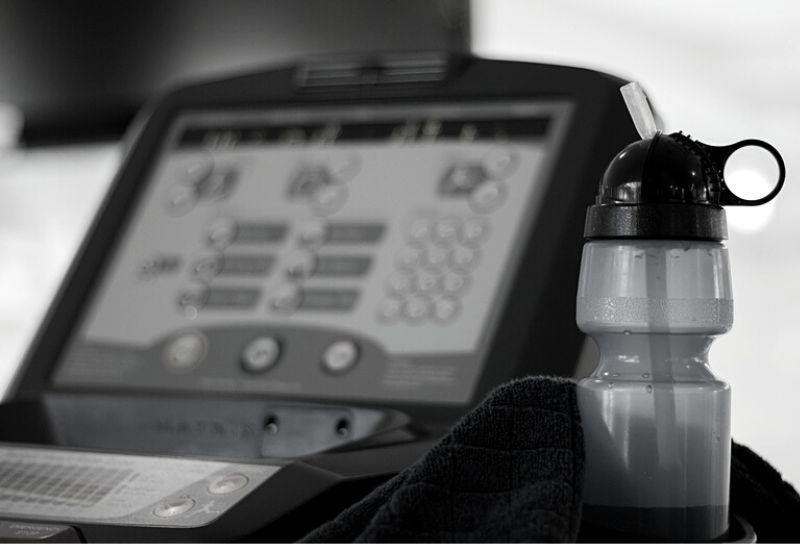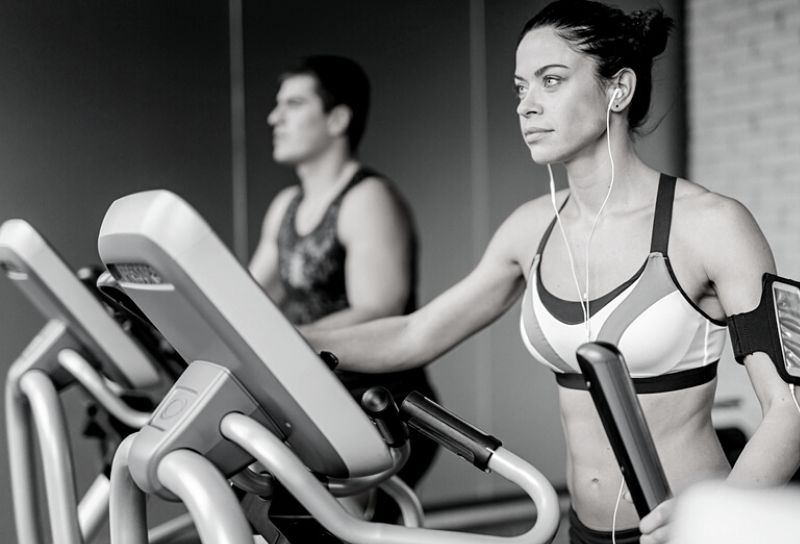Wondering whether the elliptical or running is right for you and your goals? We compare the two when it comes to calories burned, building cardio, weight loss, and more.

For a long time, running stood alone as the O.G. form of cardio for athletes and trainees alike.
Over the years, however, a huge range of cardio machines has exploded on the scene, providing many of the same cardiovascular and fat-burning benefits of the treadmill and overground running.
Stationary bikes. Arc trainers. Erg machines. Stair climbers. Ski ergs. Spin bikes. Assault bikes. And so on.
And then there is the mighty elliptical machine, which simulates the gait of running without the impact.
In this article, we are going to drill down on the key differences between the two machines, how many calories they burn, which is best for HIIT workouts, and much more.
By the end, you will have a clear idea of whether you are going to hit the elliptical or the treadmill the next time you go to the gym.
Let’s jump right in.
Elliptical vs Running – Calories Burned
Let’s start off with an easy one: how many calories can you burn on each of the two machines? And which one is the best cardio machine for burning calories?
According to Harvard Medical School, in just 30 minutes of training, a 185-pound person will burn:
- 378 calories on the elliptical machine
- 336 calories running a 12-minute mile (5 MPH)
- 420 calories running a 10-minute mile (6 MPH)
- 377 calories running cross-country
As you can see, the key to how many calories are burned on the elliptical or the treadmill will depend entirely on how fast you move.
The average “jogging speed” is between 4 and 6 MPH, which means you can burn as many as 420 calories in a 30-minute jog at 6 MPH. Compare that to a standard-pace elliptical workout, and sure, the treadmill burns more.

But what happens if you speed up your pedaling on the elliptical machine to match the “speed” of your 10-minute mile? Or if you increase the resistance to mimic the conditions of a hill or trail run? Well, then your calorie-burning increases!
Ultimately, it comes out to roughly the same amount of calories burned on both machines, depending on your speed and the incline/resistance.
Elliptical vs Running – Weight Loss
As you know, one of the main treadmill and elliptical benefits is the fact that the machines encourage weight loss.
Because you’re doing an aerobic workout (meaning your body can absorb oxygen into the muscles, and thus burn fat as well as sugar-based energy), you will ultimately see good weight loss over weeks and months of consistent training on these machines.
We all know that running is great for weight loss, because it uses a lot of energy (see the “Calories Burned” section above).
Fun Fact: Research comparing treadmill running vs ellipticals and stair climbers found that all three machines generated the same amount of oxygen consumption, elevated heart rate, and energy expenditure at 60, 70, and 80% intensities [1].
The elliptical machine is equally effective at burning energy, but it activates more muscles (see the “Muscles Worked” section below) and thus may burn more fat/weight from around your midsection.
The difference, though, is minor enough that both types of exercise are pretty much equal in terms of weight loss results.
The main advantage of the elliptical is that you can do extended cardio—40-60 minutes, for example—and reduce the likelihood of injury.
Elliptical vs Running – Cardio
Cardio, or cardiovascular conditioning, refers to your cardiovascular system’s ability to function properly.
This means your lungs absorb oxygen into your bloodstream, your heart pumps it throughout your body to fuel your muscles as they work, and your blood vessels dilate properly in response to allow the oxygenated blood to flow where it needs to go.
Any exercise that elevates your heart rate and keeps it at the elevated rate for prolonged periods of time will be excellent for developing cardiovascular endurance. Both treadmill running and elliptical training are great options for building cardio.

However, in this, I believe I’ve got to give the slight edge to running.
Elliptical training is lower-impact and slightly lower-effort in terms of cardio (it’s the increased muscular engagement that burns more calories, ultimately).
Running pushes your cardiovascular system very effectively and builds endurance marginally more efficiently than elliptical training.
Elliptical vs Running – Functional Fitness
When I think about using a cardio machine for weight loss, I’ve also got to think about the “functional” aspects of things—i.e., will it make me fitter in the other activities of my daily life?
In this, treadmill running usually takes the edge by a wide margin.
Think about it: how many times in your daily life are you going to be walking/pedaling with the backup of handles that allow you to use your arms to help your legs work?
The closest you’ll come to that particular combination of motion is when walking/hiking using trekking poles. Otherwise, it’s a motion specific to the training machine.

Oh, sure, you’ll pedal every time you ride a bike or stride as you walk, and you’ll definitely be pushing and pulling on heavy objects all day long.
But that specific combination of movement just isn’t found outside the gym.
Running, on the other hand, is a critical component of virtually every sport, as well as a lot of activities.
You can run after your kids, run with your pet, jog with friends, run a race, or even end up running to catch the bus or train on your daily commute.
Being able to run faster and/or for longer without tiring is a much more “functional” form of fitness, so treadmill (and outdoor) running is the winner if this is your primary objective in your training.
Elliptical vs Running – HIIT Workouts
Both the treadmill and elliptical can be used as a machine for HIIT workouts very effectively!
With the treadmill HIIT workout, you’ve got two options: raise the incline (treating it like hill/stair runs), or increase the speed (treating it like sprints).
Both are highly effective HIIT workouts, especially if you can pre-program the treadmill to speed up and slow down automatically, without your needing to operate the buttons.
With the elliptical HIIT workout, you’ve got three options:
- Raise the incline
- Increase the intensity,
- Pedal faster
Some elliptical machines allow you to pre-program your workout so the incline and resistance is automatically adjusted hands-free, but that’s typically only the higher-end models.
Thankfully, though, no adjustment is needed for you to speed up to max intensity—just pedal harder and work those handles faster.

Ultimately, both machines are pretty great for HIIT workouts.
The only reason I’d give the elliptical a slight edge is due to its low-impact nature (see the “Impact and Enjoyment” section below).
Elliptical vs Running – Muscles Worked
On this, the winner is very clear: the elliptical takes it by a mile!
On the treadmill, you’re really only working the muscles in your lower body—quads, hamstrings, calves, and glutes—with a bit of core engagement to maintain your balance and stride as you run.
Compare that to the list of muscles worked on the elliptical, though, and there’s a huge difference!
There is all the same lower body engagement to shred your legs, glutes, and hamstrings like a beast.
However, your core actually works harder on the elliptical machine in order to A) keep you steady/balanced, and B) twist your upper body as you push and pull on the handles.
Then there’s the engagement of your chest, shoulders, and triceps with every push and your back, biceps, and shoulders with every pull on the handles.
The elliptical delivers a full-body workout and targets more muscles than any other cardio machine in the gym.
There’s no doubt that it wins this particular match-up in a landslide.
Elliptical vs Running – Impact
When talking about “impact”, I’m referring to the direct impact that your movement has on your joints and bones.
Every time you lift your feet and plant them on the ground, there is varying degrees of impact running up your skeletal system.
Over time, high-impact exercise will strengthen your skeletal system, but can also cause wear and tear, even lead to joint injuries. Low-impact exercise isn’t necessarily better, it’s just gentler on your joints and thus safer for those with existing joint problems.

Running is a high-impact exercise, no doubt about it. You’re transferring your entire weight to your front foot with every step, meaning all of that weight is coming down hard on the muscles, joints, and bones of your feet, ankle, knee, leg, and hip.
The impact will often travel all the way up your spine and cause tension or pain in your shoulders and neck.
Elliptical training, on the other hand, is almost no-impact.
You never lift your feet off the pedals, so it’s a much smoother transition of shifting your weight to your front foot rather than planting it on a hard surface.
Elliptical training is much gentler on your joints, less likely to lead to long-term joint pain, and a safer rehab workout for anyone recovering from bone, joint, or muscle injuries or surgeries.
Elliptical vs Running — Enjoyment
Last, but definitely not least, there’s the enjoyment factor of your workout!
Not everyone loves huffing and puffing for an hour every day, but it’s necessary for our weight loss and fitness, so we endure.
Both the treadmill and elliptical machine offer similar workouts, and will both be about equally enjoyable. You can watch TV on the built-in screens, listen to music while you train, or just focus on the workout without outside distractions.
But I’ve got to again give a slight edge to the treadmill for the simple fact that training your running endurance in the gym means you’ll be able to run for longer in the great outdoors.
There is something truly spectacular about going for a run along a river, down a boardwalk, around a mountain or forest trail, through a park, or even by the seaside.
Running outside under the bright sun can be truly enjoyable—a far better workout than being cooped up for hours in the gym.
The Bottom Line
For calories burned and weight loss, the two machines are neck and neck. The treadmill takes the edge for enjoyment, cardiovascular conditioning, and functional fitness, while the elliptical claims gold in HIIT workouts, muscles worked, and impact.
It’s clear that both machines offer excellent benefits and thus both deserve a place in your weekly workouts.
When thinking about which machine to use, consider which of the factors above matter most, and what your ultimate fitness goal is.
My recommendation: incorporate both treadmill and elliptical training into your regimen, as that’s the smart way to develop functional fitness, vary up your workouts, and get better long-term results.
More Stuff Like This
How Much Do Ellipticals Cost? (44 Different Models Compared). Ellipticals can be a costly investment into your workout goals. Here is a look at how much each type of elliptical costs and how much to spend on one.